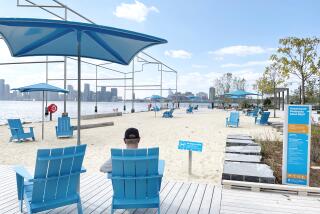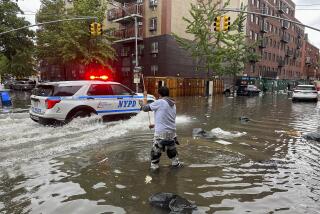As Sandy approached New York, ‘I came here to die’
- Share via
FAR ROCKAWAY, N.Y. — As the sun disappeared behind the apartment blocks on the Rockaway Inlet, Konstantin Bokov trudged up from the beach, passing a power boat nosed into a dune, its two propellers jutting out over the sand.
He was looking for the fire hydrant. The residents remaining in the dark towers above had been using it to get water to flush their toilets and to bathe.
“I came here to die with my ex-wife in the storm,” said Bokov, a Ukrainian artist who lives in Washington Heights in upper Manhattan 20 miles away.
INTERACTIVE: Before and after Hurricane Sandy
Thousands of residents in massive apartment blocks along the barrier islands that line the south shore of Long Island have remained in their homes. Despite mandatory evacuation orders issues as the massive storm approached, they stayed through Sandy’s onslaught and many are still without power or working sewer lines.
City workers like Nick Lombardo have been pulling 16-hour shifts since the storm to bring basic services back to the hardest-hit parts of New York’s five boroughs. It’s slow going. Down the block from the fire hydrant, Lombardo was working to drain a 30-foot-deep pool of sewage and sea water out of the tower block’s main sewage station.
Electricians were in the pit below, hot wiring the sewage pumps to a diesel generator.
“They’ll have working sewage tonight,” Lombardo, a New York City sanitation worker, said Saturday. Below a grate was waste water. The smell doesn’t bother him any more. “I could stand over this grate and eat a sandwich,” he said.
Back up the block, Bokov found the fire hydrant. Bokov, whose artwork sells for hundreds of dollars at a downtown gallery, is known for his whimsical painted sculptures made from trash he collects on the street.
“I don’t buy art supplies,” he said, pointing to a piece of pink dock foam and a twisted metal rod that had been washed up by the storm. “I am building from New York.”
The storm was terrifying, he said, as he tipped a black bucket under the unscrewed cap of the hydrant. He remembers seeing waves rush up past the towers on Rockaway Beach and deposit cars and docks and sand on the vast expanse of Seagirt Boulevard.
When Bokov’s bucket was full, he adjusted his hood, closed his collar against the wind and walked into one of the buildings.
ALSO:
Hurricane Sandy death toll climbs above 110
Uneasy quiet: Sandy brought New York an eerie silence
N.J. begins gas rationing as region rebounds in Sandy’s wake
More to Read
Sign up for Essential California
The most important California stories and recommendations in your inbox every morning.
You may occasionally receive promotional content from the Los Angeles Times.














